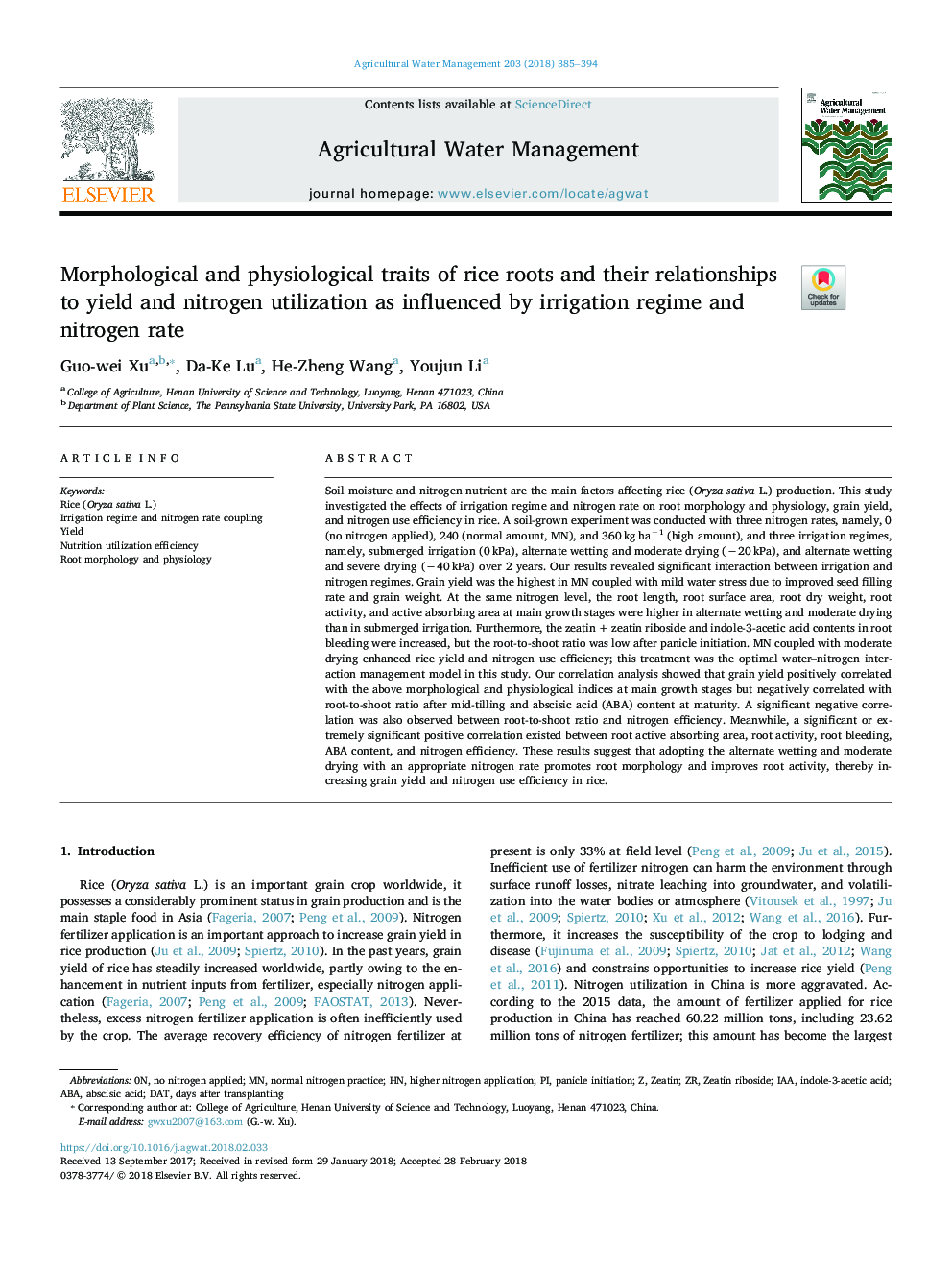| کد مقاله | کد نشریه | سال انتشار | مقاله انگلیسی | نسخه تمام متن |
|---|---|---|---|---|
| 8872987 | 1622877 | 2018 | 10 صفحه PDF | دانلود رایگان |
عنوان انگلیسی مقاله ISI
Morphological and physiological traits of rice roots and their relationships to yield and nitrogen utilization as influenced by irrigation regime and nitrogen rate
ترجمه فارسی عنوان
صفات مورفولوژیک و فیزیولوژیک ریشه برنج و روابط آنها با عملکرد و مصرف نیتروژن تحت تأثیر رژیم آبیاری و میزان نیتروژن
دانلود مقاله + سفارش ترجمه
دانلود مقاله ISI انگلیسی
رایگان برای ایرانیان
کلمات کلیدی
موضوعات مرتبط
علوم زیستی و بیوفناوری
علوم کشاورزی و بیولوژیک
علوم زراعت و اصلاح نباتات
چکیده انگلیسی
Soil moisture and nitrogen nutrient are the main factors affecting rice (Oryza sativa L.) production. This study investigated the effects of irrigation regime and nitrogen rate on root morphology and physiology, grain yield, and nitrogen use efficiency in rice. A soil-grown experiment was conducted with three nitrogen rates, namely, 0 (no nitrogen applied), 240 (normal amount, MN), and 360â¯kgâ¯haâ1 (high amount), and three irrigation regimes, namely, submerged irrigation (0â¯kPa), alternate wetting and moderate drying (â20â¯kPa), and alternate wetting and severe drying (â40â¯kPa) over 2 years. Our results revealed significant interaction between irrigation and nitrogen regimes. Grain yield was the highest in MN coupled with mild water stress due to improved seed filling rate and grain weight. At the same nitrogen level, the root length, root surface area, root dry weight, root activity, and active absorbing area at main growth stages were higher in alternate wetting and moderate drying than in submerged irrigation. Furthermore, the zeatinâ¯+â¯zeatin riboside and indole-3-acetic acid contents in root bleeding were increased, but the root-to-shoot ratio was low after panicle initiation. MN coupled with moderate drying enhanced rice yield and nitrogen use efficiency; this treatment was the optimal water-nitrogen interaction management model in this study. Our correlation analysis showed that grain yield positively correlated with the above morphological and physiological indices at main growth stages but negatively correlated with root-to-shoot ratio after mid-tilling and abscisic acid (ABA) content at maturity. A significant negative correlation was also observed between root-to-shoot ratio and nitrogen efficiency. Meanwhile, a significant or extremely significant positive correlation existed between root active absorbing area, root activity, root bleeding, ABA content, and nitrogen efficiency. These results suggest that adopting the alternate wetting and moderate drying with an appropriate nitrogen rate promotes root morphology and improves root activity, thereby increasing grain yield and nitrogen use efficiency in rice.
ناشر
Database: Elsevier - ScienceDirect (ساینس دایرکت)
Journal: Agricultural Water Management - Volume 203, 30 April 2018, Pages 385-394
Journal: Agricultural Water Management - Volume 203, 30 April 2018, Pages 385-394
نویسندگان
Guo-wei Xu, Da-Ke Lu, He-Zheng Wang, Youjun Li,
